June, 1951
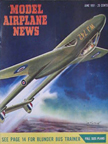
De Havilland D.H.100 "Vampire"
Model Airplane News Cover Art for June, 1951
by Jo Kotula
Click to Enlarge
The de Havilland DH.100 Vampire was a British jet-engine fighter. It was commissioned by the Royal Air Force during the Second World War, and was the second jet fighter to enter service with the RAF, after the pioneering Gloster Meteor. Although it arrived too late to see combat during the war, it served with front line RAF squadrons until 1955, and continued in use as a trainer until 1966. It also served with many air forces worldwide, and set several aviation firsts and records. Almost 3,300 Vampires were built, a quarter of them under licence in other countries. The Vampire design was also developed into the de Havilland Venom fighter-bomber as well as naval Sea Vampire variants.
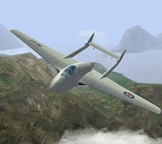
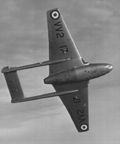
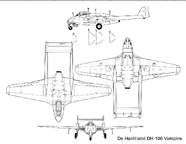
Photos of the De Havilland D.H.100 "Vampire"
Click to Enlarge
The Vampire was considered to be a largely experimental design due to its unorthodox arrangement and the use of a single engine, unlike the Gloster Meteor which was always specified for production. The low-powered early British jet engines meant that only twin-engine aircraft designs were considered practical; but as more powerful engines were developed, a single-engined jet fighter became more viable. De Havilland was asked to produce an airframe for one of these powerful new engines. The first design was an all-metal, twin-boom, tricycle undercarriage aircraft armed with four cannon. The use of a twin boom (similar to that of the Lockheed P-38) kept the jet pipe short which avoided the power loss of a long pipe that would have been needed in a conventional fuselage. The DH.99 was modified to a mixed wood and metal construction in light of deHaviland's skill in working with molded plywood (as in the Mosquito and the design was renumbered to DH.100 by November 1941. The production Vampire Mk I did not fly until April 1945, with most being built by English Electric Aircraft due to the pressures on de Havilland's production facilities which were busy with other types. Although eagerly taken into service by the RAF, it was still being developed at war's end, and consequently the Vampire never saw combat in the Second World War.
De Havilland initiated a private venture night fighter, the DH.113 intended for export, fitting a two seat cockpit closely based on that of the Mosquito night fighter, and a lengthened nose accommodating AI Mk X radar. An order to supply the Egyptian Air Force was received, but this was blocked by the British government as part of a general ban on supplying arms to Egypt. Instead the RAF took over the order and put them into service as an interim between the retirement of the de Havilland Mosquito night fighter and the full introduction of the Meteor night fighter. Removal of the radar from the night fighter and fitting of dual controls gave a jet trainer, the DH.115. This was built in large numbers, both for the RAF and for export. A total of 3,268 Vampires were built in 15 versions, including a twin-seat night fighter, trainer and carrier-based aircraft designated Sea Vampire. It was used by some 31 air forces. Germany, Spain and the U.S. were the only major Western powers not to use the aircraft type.
Here is a video of the De Havilland D.H.100 "Vampire" in action:
In addition to the cover of Model Airplane News, this airplane was also featured in the WINGS "Friend or Foe" trading card series of the early 1950s
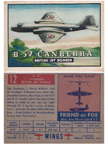
Trading card representation of the De Havilland D.H.100 "Vampire"
Click Here to see all 200 cards in the series
Click to Enlarge
Click Here for more information about the De Havilland D.H.100 "Vampire" .

Click to go back and select another cover.
Counter for the Entire Site (not just this page..)
Home | About Lindy | Last Week's Reviews | Upcoming Events | 1940s Collecibles
The Guide - Establishments - Travel - Accessories
Music | Links | Photo Gallery | Extras | Contact